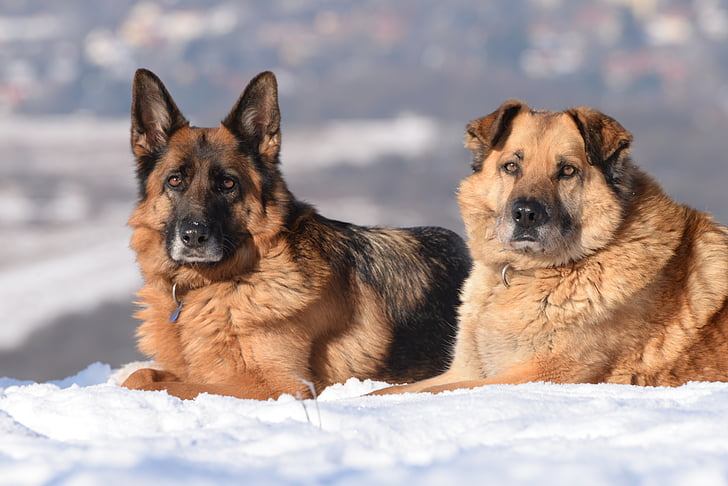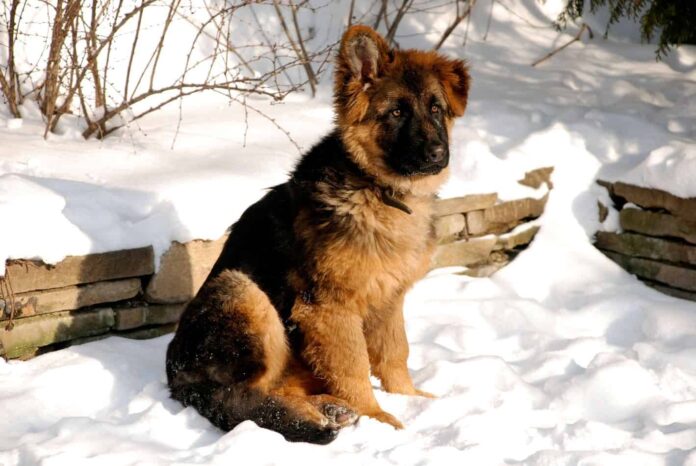Last Updated on August 30, 2021 by Fumipets
German Shepherds are popular all across America and are renowned for their versatility as working dogs, but how will they do if you spend a lot of time outside in the cold? Here’s all you need to know about German Shepherds and how they deal with the cold.
Are German Shepherds built to withstand the cold? German Shepherds are big, energetic dogs with thick double coats that keep them warm when it’s chilly outside. Because Germany is renowned for its severe weather, it’s shouldn’t be a surprise that this German herding breed is well-built for the cold.
Are all German Shepherds equally well suited to the cold? What should you remember while taking your German Shepherd out in the snow?
Everything you need to know about German Shepherds and cold weather is right here.

What Makes German Shepherd Dogs a Cold-Weather Breed?
The German Shepherd is regarded as the best working dog in the world, with a reputation for loyalty, bravery, and calmness in the face of danger. However, what makes them a good cold-weather breed?
History
German Shepherds were trained to work year-round in the frigid conditions that are characteristic of Germany, so they have always been used to cold weather. German Shepherds were raised to be livestock herders and guardians, thus they spent the majority of their time with their flock out in the weather.
German Shepherds have been trained as combat dogs, police dogs, and security dogs throughout the years. German Shepherds have to be able to withstand long days of cold weather in each of these jobs.
Size
The size of German Shepherds is the first physical trait that prepares them for the cold. Male German Shepherds weigh 65 to 90 pounds, while females weigh 50 to 70 pounds. Shepherds’ large stature provides them with enough mass to keep them warm when the temperature drops.

Coat
The thick coat of a German Shepherd protects them from the cold. The medium-length double coat of the AKC standard German Shepherd.
The outer layer is thick, a little rough to the touch, and lays close together for a sleek look. The undercoat is silky and luxurious, and it offers a lot of insulation.
These two jackets complement each other, with the outer coat offering weather and wind protection and the inside coat giving dry insulation no matter the weather.
It is essential to remember that the AKC does not recognise a different coat type in German Shepherds. Long-haired German Shepherds have a much longer coat than normal Shepherds approved by the AKC.
Importantly, although long-haired German Shepherds may seem fluffier and appear to be better in the cold, they usually only have one coat, rather than the double coat that the normal German Shepherd has.
Long-haired Shepherds are considerably more susceptible to the cold than short-haired Shepherds because they lack the thick undercoat needed to insulate them. Your long-haired Shepherd will get chilly quicker and be less weather-resistant than shorter types. They also shed less, which is a benefit.
Long-haired Shepherds sometimes have an undercoat, which is uncommon. They would probably fare much better in the cold than short-haired Shepherds in similar situations.
If you’re looking for a German Shepherd who thrives in the cold, the double-coated long-haired Shepherd may be worth looking for. Keep in mind that, although having a double coat like the AKC-approved type, these dogs are not recognised by the AKC.
Activity
The German Shepherd is an energetic breed that can likely remain warm on a cold day just by keeping occupied. Your Shepherd will most likely want to run for many hours each day, and Shepherds are trained in a variety of activities ranging from agility to herding to track.
This is a dog that is bred to be active all day, regardless of the weather, and all of that movement keeps your Shepherd warm.

How Cold Is Too Cold?
Unlike other Northern breeds such as Huskies, Saint Bernards, and Malamutes, who were intended to live and sleep in the snow, German Shepherds were developed to live and work with humans and cattle. Even the coldest weather won’t bother your Shepherd as long as they’re moving and active.
The Shepherd’s paws were not intended to run through snow all day for lengthy periods of time; instead, they have spurts of activity interspersed with time to lick their paws. Paw protection is required if you anticipate your dog to run all day in the snow.
Cold Weather Tips
You may believe that your Shepherd will be just well in the cold. After all, this is why they were created, and your Shepherd isn’t slowing down any time soon. Even if your dog seems to be enjoying himself in the snow, there are certain things you can do to make it safer and simpler for him.
Watch Your Dog’s Temperature
Keep an eye on your dog’s temperature readings. They’re usually OK if they’re panting while running and playing. If your dog is running a lot without panting, and particularly if you see them shivering or looking sluggish, take them someplace warm right away.
Paw Balm
Paw balm has long been used to protect the paws of dogs that must trek through ice and snow. Musher’s Secret Pet Paw Protection Wax is well-known for its ease of application.
Vitamin E is used in the mix to help heal wounds and keep paws healthy. To protect your dog’s paws from ice, snow, and salt, just rub it on before going outdoors.

Is It Possible For A German Shepherd To Freeze To Death?
While German Shepherds are more immune to the cold than other breeds, they may still succumb to the cold. In cold conditions, a Shepherd left without cover or with just a basic shelter may succumb and freeze to death.
Pregnant and lactating moms, as well as young and elderly canines, are more susceptible. This is not a dog that should be left out in the weather all day, but rather a companion for the cattle or the family.
How Do German Shepherds Do In Hot Weather?
The German Shepherd has a flexible coat that allows it to thrive in a variety of climates. You can expect your German Shepherd to handle the heat just well as long as you give them enough water and don’t overwork them.
Never try to calm down your German Shepherd by shaving him. Their double coat is intended to keep them cool by regulating their temperature. Long-haired, single-coated Shepherds, on the other hand, may benefit from having trimmed in warmer weather.

Related Questions
How Do I Protect German Shepherd Paws If They Hate Paw Palm?
Dog boots are a great method to protect your German Shepherd’s paws from snow, ice, and debris if your dog can accept them. These are an excellent option if your dog spends long hours, particularly on shaky terrain.
The easiest method to teach your dog to wear boots is to praise and divert them at first, then immerse them in activities so they don’t notice what’s on their feet.
Can German Shepherds Sleep In The Snow?
Shepherds will soon get chilly outdoors in the snow after the workday is done or when your dog is less active. Shepherds were trained to labour hard in the cold but sleep comfortably in the heat. Shepherds must sleep in an insulated barn with their animals or at home with their families.

















